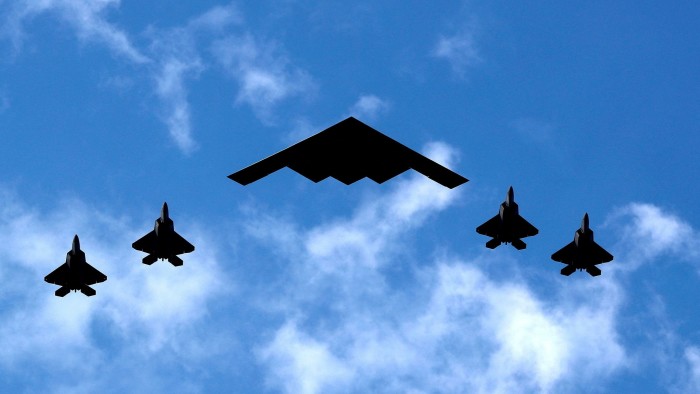Mehul Srivastavain London andSteff ChávezandDemetri Sevastopuloin Washington
Your guide to what Trump’s second term means for Washington, business and the world
The US is moving B-2 stealth bombers into the Pacific, as President Donald Trump considers whether Washington will join Israel’s war against Iran.
According to flight trackers and a person familiar with their deployment, multiple B-2 bombers appeared to be travelling from Missouri to the US base on Guam in the Pacific early on Saturday.
It was not clear if the moves were a sign that the US was preparing for a potential strike on Iran. The person cautioned that it was not uncommon to reposition military resources to be ready for any possible deployment.
The bombers are also sometimes sent to particular areas to provide additional deterrence by reminding countries of the reach of the US Air Force.
The Pentagon referred questions to the White House, which did not respond to requests for comment.
US “bunker-buster” bombs carried by B-2 stealth bombers are deemed to have the best chance of destroying the crown jewel of the Islamic Republic’s nuclear programme, the sprawling uranium enrichment facility built deep under a mountain in Fordow.
Israel, which has sought to eliminate Iran’s nuclear infrastructure since its surprise attack on the country on June 13, is considered to have neither the bombs nor the aircraft to destroy Fordow, so would probably have to rely on US assistance to do so.
The White House said on Thursday that Trump would decide “within the next two weeks” if the US would strike Iran, a decision that would mark a significant escalation in the conflict.
The state department has begun evacuation flights for American citizens and lawful permanent residents from Israel, US ambassador to Israel Mike Huckabee said on Saturday. The US started evacuating diplomats from the country on Wednesday. Huckabee said this week that the US government was also looking for cruise ships to help Americans leave Israel.
The US president is due to hold a national security meeting at the White House on Saturday.
On Saturday, Iran’s foreign minister Abbas Araghchi warned that it would be “very, very dangerous for everybody” if the US were to join the conflict.
“Unfortunately, we have heard that the US may join this aggression,” Araghchi told reporters. “That would be very unfortunate.”
Israel’s near-complete domination of Iranian skies has severely curtailed the Islamic Republic’s missile launch capabilities and eliminated much of its senior military leadership since the start of the conflict earlier this month.
Supreme Leader Ayatollah Ali Khamenei has rarely been seen in public since Israel’s defence minister said that he too could be assassinated.
The Israeli military’s success has left Trump reluctant to agree to an Iranian demand that any talks take place under the cover of a ceasefire.
“It’s very hard to stop when you look at it, Israel’s doing well in terms of war and I think you would say that Iran is doing less well,” Trump said on Friday, describing the first round of Europe-led negotiations in Geneva as ineffective. “Europe is not going to be able to help with this.” The US did not attend the talks.
A person briefed onFriday’s negotiationssaid the French, German and UK foreign ministers warned their Iranian counterpart that Tehran may have to give up its red line of refusing to negotiate with Washington while under Israeli attack to “prevent the US from joining the operation”.
“We sent them away to think very carefully about their red line,” the person said. “We told [the Iranians] that US military intervention is something that is actually being planned right now.”
French President Emmanuel Macron said he had been in contact with Masoud Pezeshkian, his Iranian counterpart, and planned to accelerate the Europe-led negotiations.
“Here again, my position is clear: Iran must never acquire nuclear weapons, and it is up to Iran to provide full guarantees that its intentions are peaceful,” he wrote on X on Saturday.
Trump has dismissed the US intelligence community’s assessment that Iran was not using Fordow’s uranium enrichment capabilities to build material for a nuclear weapon. Instead, he has agreed with Netanyahu’s claims that Tehran was weeks from building a bomb.
“She’s wrong,” Trump told reporters when asked about national intelligence director Tulsi Gabbard’s testimony to Congress this year, which contradicted Netanyahu’s insistence that Iran was building a bomb.
Gabbard said in March that the US intelligence community believed that Iran was not building a nuclear weapon and that Khamenei had not revived the programme he suspended in 2003.
But late on Friday night, Gabbard wrote on X that if Iran decided to finalise the assembly of a bomb, it could “produce a nuclear weapon within weeks to months”.
Earlier on Saturday, Israel struck Iran’s nuclear facility near Isfahan. According to the Iranian Fars news agency, the actions appear to have hit some parts of the nuclear facility, but there were no signs of radiation leakage.
Iran also launched a small volley of missiles and drones on Saturday. All but one were intercepted, the Israeli military said, with a drone damaging a house in northern Israel.
Additional reporting by Andrew England in London
Comments have not been enabled for this article.



